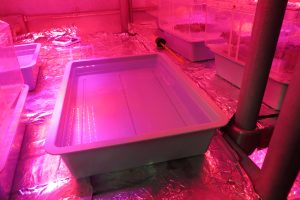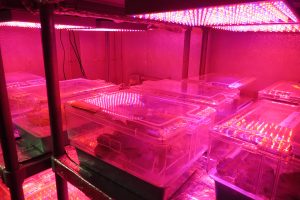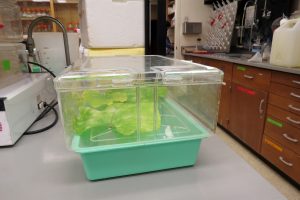- Grow melon variety Top Mark in the greenhouse in gallon (ca. 4 liter) pots. The plants are fertilized with Osmocote 14-14-14 NPK. Plants are watered every other day for a week after emergence. Later, the plants are connected to an automated irrigation system that delivers water for 2 minutes in the morning and afternoons. Irrigation frequency can be increased during the summer. For pest control, predatory mites (Hypoaspis miles, Amblyseius cucumeris) and parasitic wasp (Encarsia formosa) are used.
- Maintain the plant powdery mildew-free until the leaves are large enough to collect. When the plants are 1.5 months old onwards, they start producing leaves that are usable. Top leaves that are dark green are preferred. Younger leaves and lower leaves can grow the fungus, but may not last long enough in the detached leaf system. These are abundant during summer. During winter and spring, the plants are spindly and the leaves grow smaller. These leaves can also be used as long as they have sturdy petioles.
- Collect disease and pest-free melon leaves for growing the fungal strain. Keep the leaves moist until set-up.
- Transparent plastic boxes (Pioneer Plastics Inc, 295C, 12 5/6 x 9 1/16 x 4 inches), with holes drilled In the bottom are used for the set up. The petioles are inserted through the hole in the box so that it can be dipped in aqueous NUTRIENT SOLUTION (1500 ml) placed in a tray under the box. The distilled water is supplemented with a mix of BIK [benzimidazole (500mg), IAA (150mg) and kinetin (300mg) in 100ml of DMSO] at the rate of 10ml/ 1500ml water.
- The melon leaves are inoculated with mildew conidia grown on squash leaves by dabbing spores on the leaves. Inoculation is done in a clean hood with the air flow switched off, or in a fume hood to prevent the spores blowing into the room. The hood surfaces are cleaned with 70% ethanol to eliminate the possibility of cross contamination by different strains of the powdery mildew.
- The detached Top Mark* leaves, typically 3 or 4 per plastic box, are placed under red/blue LED lights at 18C for two weeks. The nutrient solution is topped up as necessary. In two to three weeks, depending on the sporulation ability of the strain, the fungus would grow and cover the surface of the leaf.
* This method has been successful with Top Mark. Other melon varieties were inconsistent in their behavior, often senescing and dying prematurely.




